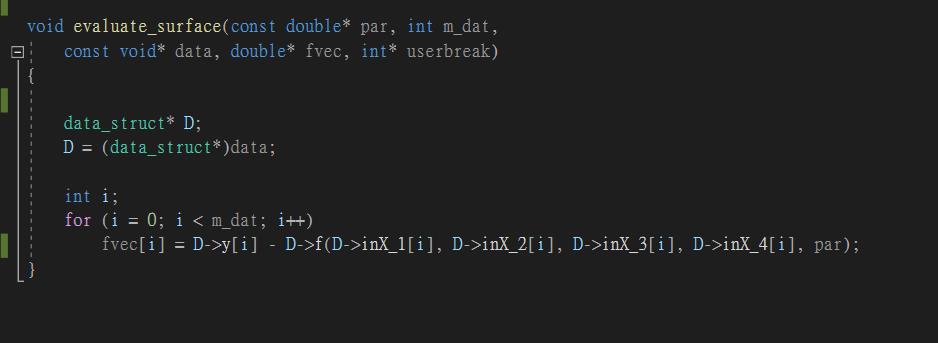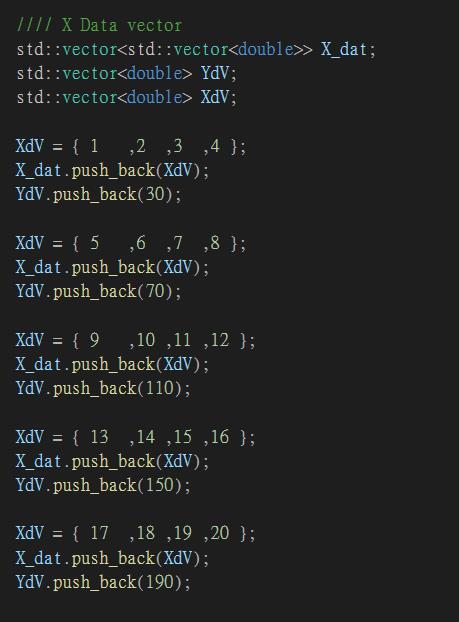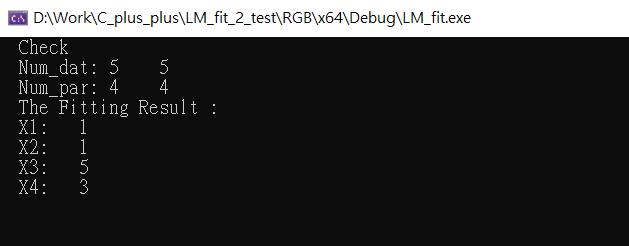LM fitting 的測試,第一集在這裡喔:https://dotblogs.com.tw/April_Notes/2021/12/08/11330
第一集在這裡喔:https://dotblogs.com.tw/April_Notes/2021/12/08/113301
這個範例為:
ax1 + bx2 + cx3 + dx4 = 30
ax5 + bx6 + cx7 + dx8 = 70
ax9 + bx10 + cx11 + dx12 = 110
ax13 + bx14 + cx15 + dx16 = 150
ax17 + bx18 + cx19 + dx20 = 190
求解: a、b、c、d 由這樣設定上可以看到:
簡單來說設定上就是:
方程式: f(X1,X2,X3,X4) = aX1 + bX2 + cX3 + dX4 = Y
Xij =
1 2 3 4
5 6 7 8
9 10 11 12
13 14 15 16
17 18 19 20
Yi =
30
70
110
150
190
這個題目用矩陣就有解,但是我們用Fitting方式來完成
Fitting的程式代碼為:
#include <cstdio>
#include <vector>
#include "lmmin.h"
#include <iostream>
#include <string>
#include <fstream>
/* data structure to transmit data arays and fit model */
typedef struct {
double* inX_1, * inX_2, * inX_3,* inX_4;
double* y;
double (*f)(double inX_1, double inX_2, double inX_3, double inX_4, const double* p);
} data_struct;
void evaluate_surface(const double* par, int m_dat,
const void* data, double* fvec, int* userbreak)
{
data_struct* D;
D = (data_struct*)data;
int i;
for (i = 0; i < m_dat; i++)
fvec[i] = D->y[i] - D->f(D->inX_1[i], D->inX_2[i], D->inX_3[i], D->inX_4[i], par);
}
double f(double X1, double X2, double X3, double X4, const double* p)
{
double Ans = X1 * p[0] + X2 * p[1] + X3 * p[2] + X4 * p[3];
return Ans;
}
const int Num_par = 4;
const int Num_dat = 5;
void Fitting_function(
std::vector<double>& par_Vector,
const std::vector<std::vector<double>>& X_dat,
const std::vector<double>& Y_dat)
{
/* parameter vector */
int n_par = Num_par;/* number of parameters in model function f */
double par[Num_par];/* arbitrary starting value */
for (int i = 0; i < Num_par; i++)
par[i] = par_Vector[i];
/* data points */
int m_dat = Num_dat;
double inX_1[Num_dat], inX_2[Num_dat], inX_3[Num_dat], inX_4[Num_dat], y[Num_dat];
for (int i = 0; i < Num_dat; i++)
{
inX_1[i] = X_dat[i][0];
inX_2[i] = X_dat[i][1];
inX_3[i] = X_dat[i][2];
inX_4[i] = X_dat[i][3];
}
for (int i = 0; i < Num_dat; i++)
y[i] = Y_dat[i];
data_struct data = { inX_1, inX_2, inX_3,inX_4, y, f };
/* auxiliary parameters */
lm_status_struct status;
lm_control_struct control = lm_control_double;
control.verbosity = 0;
/* perform the fit */
lmmin(n_par, par, m_dat, (const void*)&data, evaluate_surface, &control, &status);
for (int i = 0; i < n_par; ++i)
par_Vector[i] = par[i];
}
int main()
{
//// Initial Value
std::vector<double> par_Vector;
par_Vector.push_back(2);
par_Vector.push_back(2);
par_Vector.push_back(2);
par_Vector.push_back(2);
//// X Data vector
std::vector<std::vector<double>> X_dat;
std::vector<double> YdV;
std::vector<double> XdV;
XdV = { 1 ,2 ,3 ,4 };
X_dat.push_back(XdV);
YdV.push_back(30);
XdV = { 5 ,6 ,7 ,8 };
X_dat.push_back(XdV);
YdV.push_back(70);
XdV = { 9 ,10 ,11 ,12 };
X_dat.push_back(XdV);
YdV.push_back(110);
XdV = { 13 ,14 ,15 ,16 };
X_dat.push_back(XdV);
YdV.push_back(150);
XdV = { 17 ,18 ,19 ,20 };
X_dat.push_back(XdV);
YdV.push_back(190);
std::cout << "Check" << std::endl;
std::cout << "Num_dat: " << Num_dat << "\t" << X_dat.size() << std::endl;
std::cout << "Num_par: " << Num_par << "\t" << par_Vector.size() << std::endl;
Fitting_function(par_Vector, X_dat, YdV);
std::cout << "The Fitting Result :" << std::endl;
std::cout << "X1:\t" << par_Vector[0] << std::endl;
std::cout << "X2:\t" << par_Vector[1] << std::endl;
std::cout << "X3:\t" << par_Vector[2] << std::endl;
std::cout << "X4:\t" << par_Vector[3] << std::endl << std::endl;;
std::cin.get();
return 0;
}
簡單解釋一下:
1. 設定方程式為: f(X1,X2,X3,X4) = aX1 + bX2 + cX3 + dX4 = Y


2. 判斷的標準為: Y - f(X1,X2,X3,X4) 的最小值

3. 將X 與 Y 數值寫進去

3. 執行Fitting

來側看看

跟預計的結果相同
